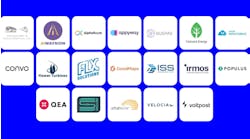How AI and 3D technologies are transforming rail security
Global demand for rail travel is growing rapidly; passenger and freight traffic is expected to double globally by 2050. As rail ridership grows, the promise of a safer and more efficient rail infrastructure is critical and must be actively pursued by rail operators.
However, rail security presents a multitude of unique challenges. There are countless vulnerabilities associated with railway infrastructure due to its complex nature and vast geographical area. Rail operators are routinely faced with an array of hazards from trespassing to theft, dangerous weather conditions and much more. Despite lower ridership in 2020 due to the pandemic, there were still 783 rail-related fatalities and more than 5,400 injuries in the United States.
There are several emerging technologies that are revolutionizing railway security and enhancing the efficiency of operations. Two of them in particular – 3D mapping technologies and artificial intelligence (AI) – are making a significant impact on the ability to reduce disruptions and protect rail assets, personnel and passengers.
As to the former, 3D mapping technologies can be further broken down into hardware as well as software components, both of which play a critical role in protecting rail infrastructure. By creating a complete, up-to-date, and easy-to-understand map, human operators can more quickly predict and detect potential security threats, then make the most informed decisions about what to do next.
Of the hardware mapping components, perhaps the most important for rail is LiDAR (Light Detection and Ranging). In short, LiDAR sensors use lasers to scan and quickly identify physical changes within the rail environment in high-value areas, perimeters and zones, such as tunnels and rolling stock. LiDAR technology is able to assess an environment significantly faster than a rail operator would be able to manually. And the faster an issue is identified, the faster an appropriate response can be made before an event like a service disruption, or something more catastrophic, such as collision or derailment.
As LiDAR scans the tracks, assets and surrounding landscape, it gathers so much minute and accurate information that it is possible for rail operators to create digital 3D maps. The most extensive versions of these 3D maps are what are commonly known as digital twins, a lifelike recreation of a real-world environment.
Digital twins are a fantastic tool for safety personnel to monitor and predict the complex interactions of a rail environment and forecast appropriate responses to potential incidents. Digital twins can be used to model not just infrastructure, but moving assets (e.g., the trains themselves) and passenger movements as well. A digital twin’s predictive capabilities empower railway operators to be proactive in preventing potentially dangerous incidents before they happen.
Yet, while 3D mapping technology is an incredible resource, generating this type of map necessitates massive amounts of data that need to be integrated and analyzed efficiently. Placing this burden on human operators alone becomes very challenging, but the process can be made more efficient by using AI. AI can quickly render digital twins as well as flag areas in which an operator might need to investigate further.
Additionally, AI filters out incidents that may be detected by LiDAR sensors but don’t necessarily need to be reviewed by the rail operators. For example, rail environments are subject to many false positives, such as wildlife crossing the track versus human intruders. This frees up human personnel to focus on potentially serious incidents.
The richer information derived from 3D and AI technologies can also be integrated with other security and surveillance software and regional collaboration channels. This helps to reduce false positives, enables real-time coordinated responses, minimizes network disruptions and risk and ensures the safety of passengers and freight.
Artificial intelligence and 3D technology complement each other to ensure a safer and more efficient railway infrastructure. They’re synergistic in the fact that AI can analyze huge amounts of data and quickly render 3D maps, and 3D maps make AI’s insights more accessible for humans. When these emerging technologies are implemented, they can significantly reduce the dangerous and costly disruptions that can occur throughout the complex rail environment. Bottom line: as rail infrastructure moves further into the digital world, rail safety improves.

Bruce Chaplin | Intergraph Corporation
As a long-time employee of Hexagon, Bruce Chaplin has deep experience across the geospatial value chain - from data acquisition, analysis and visualization to web mapping, location intelligence and real-time situational awareness. He has held senior leadership roles in Product Development, Product Management, Professional Services, Sales and Business Development. He currently leads the Go-To-Market (GTM) strategy and execution for Transportation Solutions in North America for Hexagon’s Safety, Infrastructure & Geospatial division.




